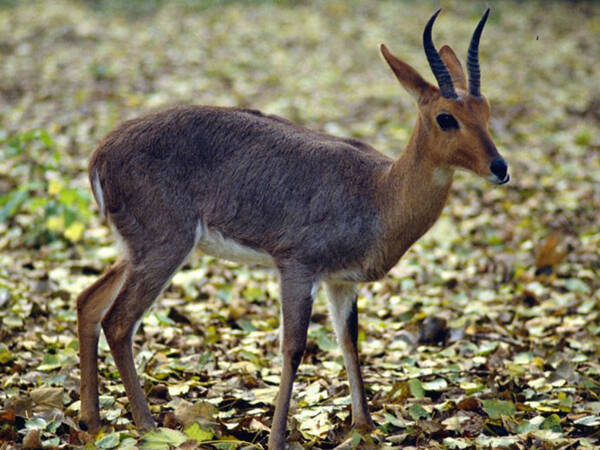Redunca fulvorufula
IUCN
LCBasic Information
Scientific classification
- name:Redunca fulvorufula
- Scientific Name:Redunca fulvorufula
- Outline:Ungulata
- Family:Artiodactyla Bovidae Reedbuck
Vital signs
- length:100-136cm
- Weight:35-65kg
- lifetime:No verification information
Feature
Fur color is mostly gray-brown to gray, with dark scent glands under the ears
Distribution and Habitat
Distributed in West Africa, East Africa and Southern Africa, there are three widely separated populations. The native range is Botswana, Cameroon, Eswatini, Ethiopia, Kenya, Lesotho, Mozambique, Nigeria, South Africa, South Sudan, Tanzania and Uganda.
Inhabits high altitude grasslands, usually on ridges and slopes covered with some trees or shrubs, at an altitude of 1,500-5,000. Active in flat areas adjacent to hills and rocky broken terrain. In areas with scattered trees, the ground is covered with green grass and there is a water source nearby.
Appearance
The mountain reedbuck is 100-136 cm long, 65-89 cm tall at the shoulder, and 18-20 cm long in the tail. Males weigh 43-65 kg and females 35-45 kg. Adult females are smaller than males. Both sexes have a soft, shaggy gray-brown coat, a reddish-brown neck, white underparts and abdomen, and dense white hair under the tail. There is a rounded patch of bare black skin (scent glands) below the long, slender ears. Only males have horns, which are very short and slightly curved forward. The horn length varies between subspecies, with the West African subspecies being the shortest at about 13 cm, the nominate subspecies being 18-22 cm, and the East African subspecies being 14-35 cm.
Details
Mountain Reedbuck (scientific name: Redunca fulvorufula) is called Mountain Reedbuck in English, Redunca de montagne in French, Rooiribbock in Afrikaans, and Bergriedbock in German. There are three subspecies.

The range size of mountain reedbuck territories ranges from 15,000-48,000 square meters. Females occupy home ranges of 0.36-0.76 square kilometers and overlap with several smaller male territories. The area defended by males may vary from 0.05 square kilometers to nearly 0.5 square kilometers. Densities of the species are usually 5-7 animals per square kilometer in South Africa and 11-33 per square kilometer in East Africa. Dominant males will mark their territories using visual displays, olfactory and auditory signals. Once these territories are marked, they usually remain there year-round.
Mountain reedbuck are social (females are usually found in small groups), but groups are not stable: individuals may change groups regularly. Mountain reedbuck usually live in groups of 6 or fewer animals. A typical group consists of one adult male and several adult females and adolescent juveniles. Dominant males will tolerate younger males, but typically, younger males form bachelor groups and live outside the group.
Mountain reedbuck can be active at any time of the day, being most active at dawn and dusk. Usually resting when the heat is high. But seems to prefer feeding in the early morning, evening, or even overnight. They use shrill whistles to signal nearby danger and also use whistles to warn other animals of their roosting areas as well as scent and visual displays. Body posture and vocalizations are used to maintain boundaries between neighboring males. Females appear to prefer territories with steep slopes to escape predators, regardless of the availability of food or water. Mountain reedbuck are herbivorous, feeding primarily on grasses. In one study, monocots made up 99.5% of rumen material. The species has the ability to selectively graze, obtaining the highest nutritional value from low-quality food.

Mountain reedbucks are polygamous. They can breed all year round, but the peak of breeding activity is in summer and autumn, while the peak of lambing season is during the summer rainy season. The interval between births ranges from 9 to 14 months, and the gestation period is usually 8 months. Each litter has one lamb. No information has been found about the care of the young by the parents of mountain reedbucks. However, in general, bovids produce precocious offspring that are able to follow their mothers from a very young age. The female provides nursing care for her young until weaning. Since the birth interval is about one year, it can be safely assumed that the offspring are weaned before the age of one year. Females can first estrus when they are 9-12 months old, but most do not reach sexual maturity until 12-24 months old. Males produce viable sperm at 1 year old.
The total population of mountain reedbuck was estimated at more than 36,000 in 1999 (33,000 of the nominate subspecies, 2,900 of the Southeast Asian subspecies, and 450 of the West African subspecies), and these subspecies still occur in large numbers on private land. Estimates for the East African subspecies in Kenya are likely to be very low, and estimates for the West African subspecies are also likely to be slightly lower; in 2004, it was reported to be common in Gashaka Gumti National Park, although numbers were declining. In 2016, the nominate subspecies unexpectedly declined by 61-73%.
Densities of mountain reedbuck in protected areas vary widely, depending on factors such as the extent of suitable habitat. Estimated densities of the nominate subspecies in protected areas in South Africa range from 0.1 or less per square kilometer in areas such as Karoo, Addo-Zuurberg and Marakele NP to 3.0-3.5 per square kilometer and 7.5 per square kilometer in Golden Gate Highlands National Park and Royal Natal National Park, and in 1977, a density of 4.9 per square kilometer was reported in the Rift Valley Rangelands of Kenya in Mountain Zebra National Park.
Listed in the "Red List of Threatened Species of the World Conservation Union" (IUCN) 2016 ver3.1-Endangered (EN).
Protect wild animals and eliminate game.
Maintaining ecological balance is everyone's responsibility!








